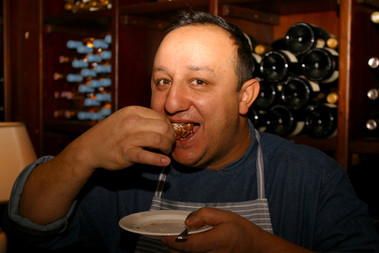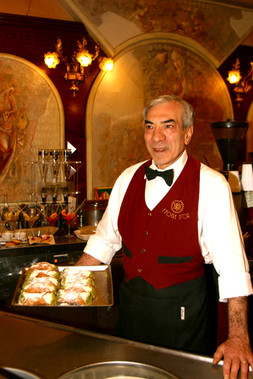Sweet heaven in a tube
July 11, 2007 - The Chicago Tribune

Somewhere along the line, Sicily’s signature dessert must have won an award for the unhealthiest dessert imaginable. Looking conspicuously like a clogged artery, the best cannoli here combine large amounts of cheese, sugar, eggs and ... pork fat.
Crunch into a good one, however, with the flavors and textures of the crisp shell surrounding the filling of subtly sweetened fresh ricotta cheese, and all those bad thoughts disappear quickly.
It’s heaven in a tube.
Walk into Modica’s Antica Dolceria Bonajuto, one of Italy’s best-known chocolatiers, and the smell is heady.
You also need to be lucky enough to know that this is where some of Sicily’s best cannoli are created. Despite the chocolate and pastries in a glass box at the counter, cannoli are not on display, and that’s one of the secrets that Pierpaolo Ruta (the latest in a long, crooked family line of chocolatiers that spans back to 1880) claims isn’t a secret.
“We really don’t have any secrets,” he said.
Then he listed some.
Who knows? Perhaps he considered them tricks.
Ruta explained a few key techniques, such as using red wine in the tube dough to give it more color and pushing the fresh ricotta through a sieve to give the filling an extra-creamy texture. He then set a plate of snow-white pork fat under my nose.
“This is the smell of my grandfather,” he said.
I raised my eyebrow, quietly praying for some sort of cross-cultural miscommunication.
“When I think of my grandfather, I think of two smells: chocolate and cannoli.”
He boils the cannoli smell down to the scent of the vanilla they put in the filling and the frying oil for the shell. Plus, here in the land where butter is a bit of an oddity, some places will fold small amounts of the fat into the crust dough.
Ruta called into the kitchen behind the shop and asked for a cannoli, giving me the feeling I was getting something that was not on the menu at a restaurant.
Here, and at any self-respecting cannoli-maker, they are made to order. This ensures that the moisture doesn’t migrate from the filling (where you want it) to the shell (where you don’t). Some places get around the problem by coating the inside of the tube with chocolate, and busy places can rely on fast turnover to keep things relatively crunchy. For orders that aren’t for immediate consumption, Bonajuto customers are sent away with a do-it-yourself box of shells and a bag of filling.
Meanwhile, in Catania ...
In Catania, Sicily’s second-largest city, the Etoile d’Or is one of the few places with enough turnover to get away with leaving their cannoli on display. Seemingly every few minutes, fresh trays of the dessert are walked out from the kitchen, 24 hours a day.
The cafe, a local favorite and a rough equivalent of an American diner, goes through a whopping 30 kilos (66 pounds!) of ricotta for its famous cannoli each day.
For owner Giacomo Munzone, ricotta is the king.
“There are two worlds of ricotta,” he said, “the industrial kind [he frowned] and the handcrafted kind which comes from farms around Catania.”
He even went as far as crediting the cheese as the reason his cannoli are one of Catania’s favorite rituals.
“It’s all about the taste and the feeling ricotta can give to it,” he said. “Sometimes you can add just a whiff of vanilla, but you’ve gotta concentrate on the ricotta. If it’s natural, this is what makes the serious difference.”
“Ricotta is the base,” he said in a half-joking mantra tone. “The base is ricotta.”
But chef Ciccio says ...
With a butcher’s build and boyish grin, Sicily’s hottest chef, Ciccio Sultano, has his own mantra.
“It’s important that the ricotta is ricotta and the crust is the crust,” he said, meaning that the flavors and textures should only mix once you take your first bite. “When you put it in your mouth, all the tastes melt into a unique experience.”
At the Michelin two-star Ristorante Duomo in Ragusa Ibla, Sultano dolls the dessert up, essentially setting a cannoli on top of a ring of ricotta that bathes in prickly pear juice next to a scoop of homemade sorbet made with local almonds, but he loves the dessert’s more humble roots.
“It’s like fast food—you eat it with your hand.”
Sultano’s cannoli are heavenly—dipped in pistachio at one end and toasted almonds at the other and barely bigger than one of his fingers. You can feel the cinnamon and powdered sugar leap from the crust and onto the sides of your mouth and tongue when you crunch into it. Inside, the ricotta is so light it’s almost like milk in some sort of suspended form.
“Normally in Sicily we can have sweet, sour, bitter and acidic flavors all in one dish. The cannoli has the sweet of ricotta with the bitter flavor of the crust,” said Sultano. “This is a real example of the contrasts of Sicily.”
But why bother revisiting a classic at one of Italy’s most avant-garde restaurants?
“Making cannoli from start to finish is a way to keep Sicilian craftsmanship alive,” he said, before reflecting a bit more.
“Why? First, because I’m Sicilian, and second,” he added with his trademark grin, “is because it’s one of the best desserts in the world.”
As for the local preference for using rendered pork fat as the frying oil, don’t knock it until you try it.
You may find yourself making more space for pork products on your dessert plate.
 A waiter delivers cannoli at The Etoile d’Or cafe in Catania which goes through a whopping 30 kilos (66 pounds!) of ricotta each day.(Photos for the Tribune by Joe Ray)
A waiter delivers cannoli at The Etoile d’Or cafe in Catania which goes through a whopping 30 kilos (66 pounds!) of ricotta each day.(Photos for the Tribune by Joe Ray)
Cannoli
Preparation time: 1 hour
Resting time: 6 hours
Cooking time: 15 seconds per batch
Yield: 18 cannoli
Antica Dolceria Bonajuto, the Sicilian pastry shop, has never given out its cannoli recipe before this. It has been adapted with reference help from “Lidia’s Italian-American Kitchen,” by Lidia Matticchio Bastianich. You’ll need 1-inch cannoli tubes (available at specialty stores) and a deep-frying thermometer.
Filling:
3 cups whole milk ricotta
1/2 cup confectioners’ sugar
2 teaspoons chopped, bittersweet chocolate
1 1/2 teaspoons finely-chopped candied orange rind
Pastry and garnish:
1 container (2 pounds) lard
1 1/2 cups unsifted flour
2 tablespoons plus 1 teaspoon sugar
1 egg plus 1 egg white
1/4 cup dry, red wine
2 tablespoons chopped toasted pistachios, see note
1. Spoon the ricotta into a large, fine-mesh sieve or colander lined with a double thickness of cheesecloth or a basket-type coffee filter. Set the sieve over a bowl, cover with plastic wrap; allow to drain at least 5-6 hours. Discard the liquid in the bowl; press the ricotta through a fine mesh sieve.
2. Beat the drained ricotta and sugar in a mixing bowl until light and fluffy, about 10 minutes. Fold in the chocolate and orange rind; cover. Refrigerate until needed.
3. Beat 2 tablespoons plus 1 teaspoon of the lard, flour, sugar, egg and wine in a bowl with a mixer on medium speed until a smooth supple dough forms, about 2-3 minutes.
4. Roll the dough out as thin as possible on a lightly-floured surface, or press dough through a pasta machine on the thinnest setting. Cut dough into 3-inch rounds, setting them on a lightly-floured kitchen towel as you cut. Re-roll the scraps of dough; cut as many rounds as possible. (You should have at least 18 rounds.) Cover; set aside 30 minutes.
5. Whisk the egg white with a few drops of water until foamy; set aside. Wrap one of the dough circles around a cannoli tube, overlapping edges. Lift the top edge; dab the lower edge with a few drops of the egg white. Press the two edges together to seal tightly. Repeat with the remaining dough and tubes. If you don’t have enough cannoli tubes to accommodate all the dough circles, work in batches.
6. Spoon enough lard into a Dutch oven to reach 3 inches deep when melted. Heat over medium heat until a deep frying thermometer reaches 350 degrees. Carefully slide a few of the shells and tubes into the hot oil. Fry, in batches, turning as necessary, until the shells are golden and blistered evenly on all sides, about 15 seconds. Remove them carefully with a wire skimmer or slotted spoon; drain on paper towel. Cool slightly; slide the shells off the tubes.
7. Fill the cannoli shells using an open ended pastry bag or a plastic food storage bag with the corner cut off; dip filled cannoli ends into chopped pistachio. Serve immediately. (Do not fill until ready to serve or rolls will become soggy.)
Note: To toast pistachios, cook in a small, dry skillet over medium heat, shaking the pan occasionally, until fragrant, about 1 minute.
Nutrition information per serving:
226 calories, 61% of calories from fat, 15 g fat, 7 g saturated fat, 40 mg cholesterol, 16 g carbohydrates, 6 g protein, 44 mg sodium, 0.4 g fiber